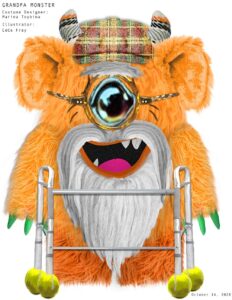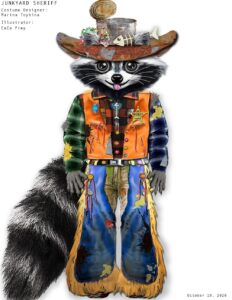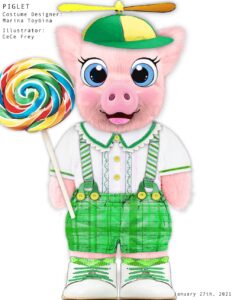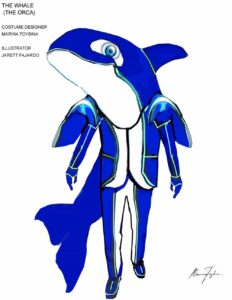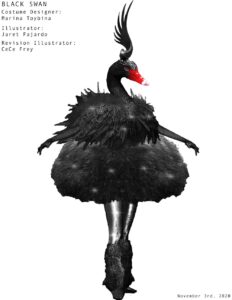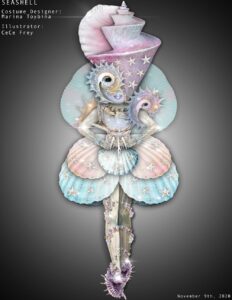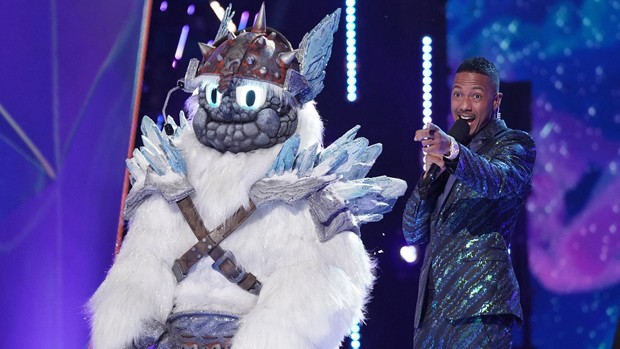
Fox’s The Masked Singer has rapidly grown into a viral sensation. While the performances are what viewers generally tune in for, especially with the appeal of trying to guess who it actually is behind the mask, no one can deny that the costumes are the true stars of the hit reality-tv singing competition. This is where Costume Designer Marina Toybina and her team step in to get the job done and stun our respective senses with these fantastical creations.
A graduate of the Fashion Institute of Design and Merchandise (FIDM) in Los Angeles, Toybina has worked with many artists on their world tours, which has lent itself to producing costumes fit for a performance stage as found on The Masked Singer. Especially when it comes to designs that cause a viral sensation. Remember those infamous sharks used in Katy Perry‘s Superbowl Halftime show? That was Toybina’s handiwork at play.
Taking what she has learned from her experiences in that particular Halftime show, and her experiences working on performing artist Pink‘s 2018 Tour, Toybina brought her expertise to The Masked Singer, where each season brought its own set of lessons and experiences to learn and grow from. All of the growth and hard work paid off, though, and it wasn’t long before the awards started coming in. Most notably, she had won her fifth Emmy Award in the Outstanding Costumes for a Variety, Nonfiction, or Reality Program category for her work on The Masked Singer at the 2020 Primetime Creative Arts Emmy Awards. Now, with the most recent fifth season having wrapped, more awards may be on the horizon for the costume designer.
Toybina tells Below The Line where she draws inspiration from when it comes to designing and bringing to life the mindblowing costumes viewers see onstage. She further explains how the team came together to work through costuming during the COVID-19 pandemic, where many worked from home and relied on hands-on techniques to get the job done without necessary resources, and she discusses how meaningful it was to bring the legendary Matroyskas to life on this most recent season of The Masked Singer. [Note: There are few minor spoilers for Season 5, so if you haven’t watched it yet, you might want to wait on this.]
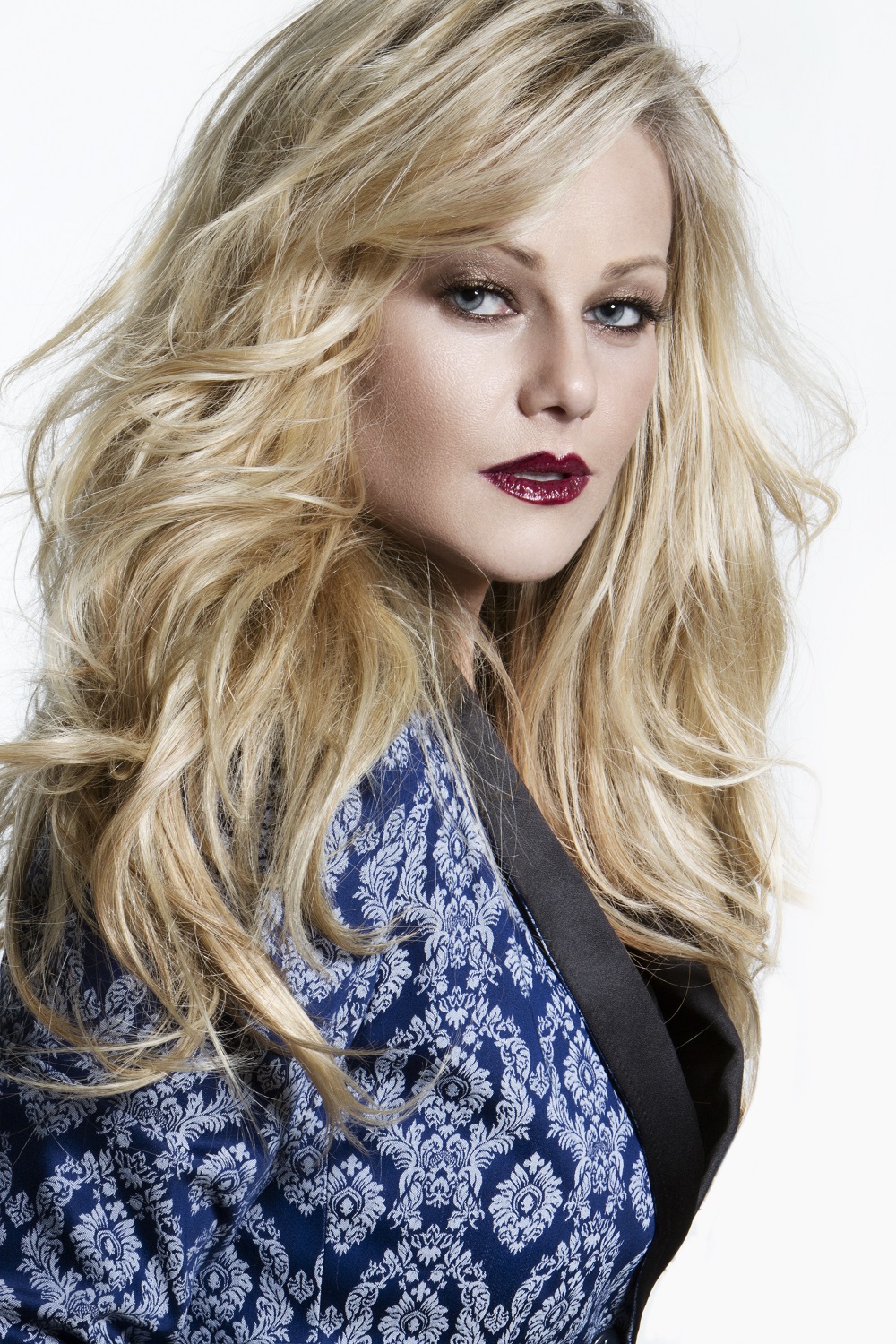
Below The Line: How are you feeling now that the finale aired?
Marina Toybina: Relieved. Relieved, but also excited because we get to jump right back into work for the upcoming season. But really happy with Season Five.
BTL: Yeah, I imagine the turnaround between seasons is really quick, because it’s so popular now.
Toybina: Yeah, for us, getting multiple seasons a year is blowing right into the next all the time, just because of how much time we really do need to set things up for the following season. So, for me, it’s always go, go, go from one to the next.
BTL: Does that normally mean that, in the middle of a season, you’re already working on sketches for the following season?
Toybina: That would be in a perfect world. [laughs] That would probably be the best-case scenario. But we really do focus on the season that we’re working with and building out first, just to really see, because every season, we tried to really elevate the show. Develop new characters, develop new ideas of design. So, being in the moment, we work on the costumes, until the very last minute, until the finale. It would be difficult to kind of start rolling into the next season. So, for me, it’s finishing one than going straight to the next.
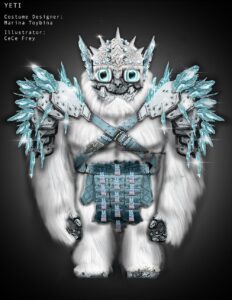
BTL: The costumes each season have gotten more and more elaborate, especially with all the details, and with the HD cameras that they have now being able to pick up every little visual detail. What is your general process of conceptualizing these costumes? And where do you get your inspiration from, because, for example, Black Swan reminded me of Tchaikovsky’s Swan Lake, and then the nesting dolls…
Toybina: Yeah, the Matryoshkas, yes.
BTL: Where do you get ideas from? How do you conceptualize them? [laughs] I’m just so fascinated.
Toybina: Every season I try to go outside the box. We see what works. We see how great we’re able to deliver certain ideas to the page. So, when it comes down to finishing one season and starting on the next, it’s really looking at the demographic. I’m also very much a fan of all the other franchises, and all the other shows that are doing the costumes and figuring out what they’re doing, what we can do differently, always using things as inspiration. For me, just like in general research, looking at old period stuff, looking at fantasy, looking at sci-fi, kind of seeing also within my pop culture phenomenon of what things can we bring to the stage that are just gonna ignite our audience with better and more over the top ideas. I also team up with a lot of the fabricators that I work with. So, the process kind of starts with the artwork first. We do research. I try to figure out what new ideas we can illustrate. What new characters can we bring to the table? And then, once discussions are then being brought forward to the production and the network, we kind of figure out our favorites what we’d like to see on the stage.
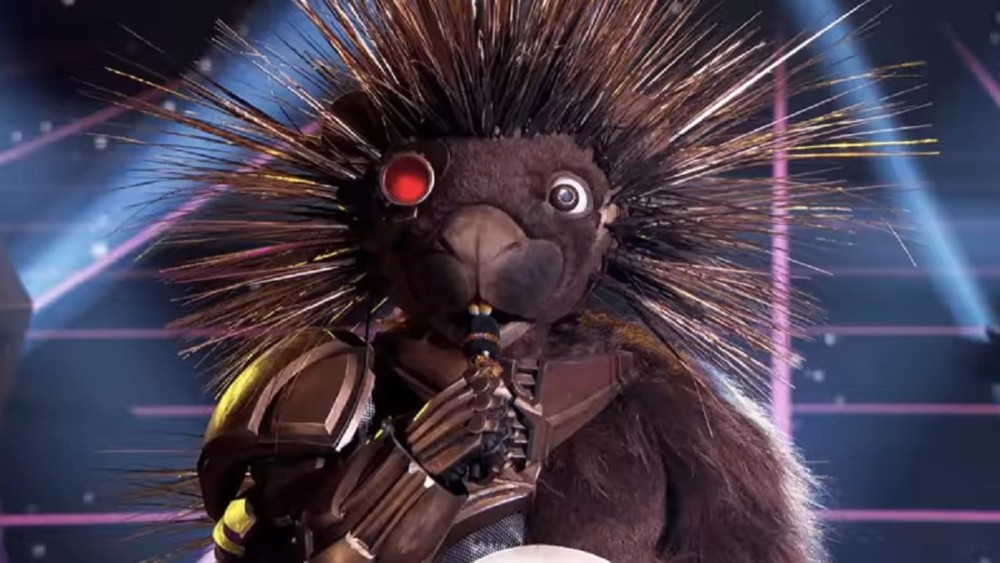
That’s when I go back to my team, and we really collaborate and try to figure out new ways and brainstorm ideas. What can we do differently on our masks? What are the textiles we haven’t experimented with yet? Where can we really use the animatronics? Or, really walk through the beginning stages of how would we address these builds. And then once the costumes are brought forward to the talent that’s being cast, we work together with them on our first welcome call to take some ideas, and then, from there, that’s when I really kind of bring the things to life and start looking at what’s available, what resources we have, and working together as one big team trying to figure out how to outdo ourselves every season.
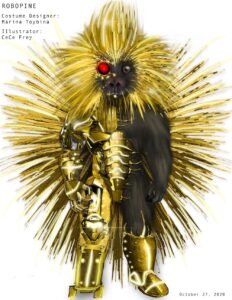
BTL: I think you answered a question that I was going to ask regarding the performers, like if they were involved from the beginning and whether they can select whatever they want.
Toybina: It is one big collaboration. Like I said, in the beginning, I kind of throw the ideas and pitch out new directions, new characters. Then when we get the chance to speak to the talent for the first time, we show them a few options of different directions that they can go into where the characters. Then that’s when I really have an open conversation with them. Do they love the artwork that we’re pitching, or is there something significant that they had in mind? The majority of the time, we get very lucky to where they just love the characters that we pitch to them. And I do have moments where they’ll come back to me with something that’s very special to them, or things that they just absolutely love. I then have a few more days to turn that into rendering, and then pitch it back to them. So, from that point that I have them on the phone, it does become a very open conversation, me explaining to them the process. Them giving me feedback. And then, we really do collaborate when it comes to fittings, and the final stages before the costume is on stage; we walk through all that with them. So, they’re very much involved for the time that I have with them.
BTL: With COVID-19, and how quickly everything needs to get done, how did that impact the process of building and making adjustments to the costumes throughout the season?
Toybina: Season Four was probably the toughest for us since the production opened up right as we went into the quarantine. So, at that moment, it did hinder us a little bit. We were very limited on resources, really had to be creative, and also think about all the protocols and all the safety that went into being able to pull this off. So, we worked very close, but yet afar as a team, and had our social distancing. A lot of the times we had to accommodate or doing build from home, really coming together collectively to see what do we have to work with. How can we pull this off? How can we get more creative? Since less things were available to us, we utilized what we had on hand, and then went back into almost the basics of custom design. Instead of using machinery, we’re going to do things by hand. Instead of printing on textiles, we’re going to fabricate with what’s available and create our own patterns and cuts. So, a lot of it was very hands-on.
I think with Season Five, we got to really almost become stronger in that scenario, as we were very much familiar with what’s going on in the world. You know, how can we pull this off? How can we work together in these conditions again? But at the same time now we let our imaginations flow. So, I think we see that progression during COVID as well throughout the two seasons, that we really pulled out all the stops to make it happen.
BTL: It happened so fast. I forgot that Season Four happened right as quarantine started. 2020 felt like five years.
Toybina: Right? [laughs] It’s crazy. But I think it was walking into the unknown. We knew the format of the show. We knew the work that had to get done. It was just a lot of red flags for us. And, instead of falling apart, I think we really came together as a unit and as a production, and tried our best to bring some lightness to the situation, and then deliver a show that would just take the stars away from the audience, and still be colorful and bright and joyous and unique and different. It worked for us with Season Four as difficult as it was. But I think with Season Five, that’s probably one of my favorite seasons because I do think the imagination just went through the roof. I think we were all having these built-up frustrations of what’s going on, and trying to turn negative into positive and really just create a world of love and art. That, to me is what Season Five was.
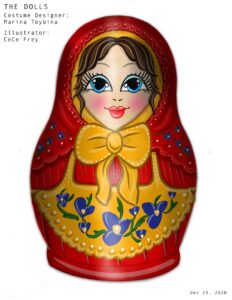
BTL: I have to say seeing the nesting dolls brought such childhood nostalgia for me. Was that the most difficult to build, because you had to essentially create multiple or near-identical versions?
Toybina: It was probably one of the most meaningful costumes to me as well, and I grew up in Moscow. I was born in Moscow, Russia, so this was really important for me to execute properly, be as authentic, and at the same time, as creative as we could be. Of course, it was such a perfect casting for this costume. The idea of the Russian dolls that I’ve been pitching since season two, and it was just never the right moment to do something like this. To really pull it off, we needed a multicast to really play with the idea of how can we execute these various kinds of formations of one doll. So, it was challenging. It was difficult, because everything has to be at a grand scale. But also, a lot of it was handwork. We couldn’t just airbrush the dolls. Everything was hand-painted in order to replicate their identical features. Everything has to be projected out, projected in. [You] really create a beautiful silhouette that has this idea of what a nesting doll is, and really focus on the artwork, and how traditional I wanted them to be.
So, it was a great collaboration with the Hanson Brothers to really pull this off together with me, because it really is a task that has to be addressed from all sides. So, they were so wonderful being able to understand the creativity behind it. We had to then go back and figure out how to make them as comfortable as possible with this cylindrical build, not your typical just a mask and costume. I think together it has this beautiful energy around it that it just worked. It was so much fun and it’s a fan favorite worldwide, which is so incredible. That on our show, we were very inclusive culturally, and I think it inspired a lot of other countries and people. So, it was wonderful to see the response that we got.
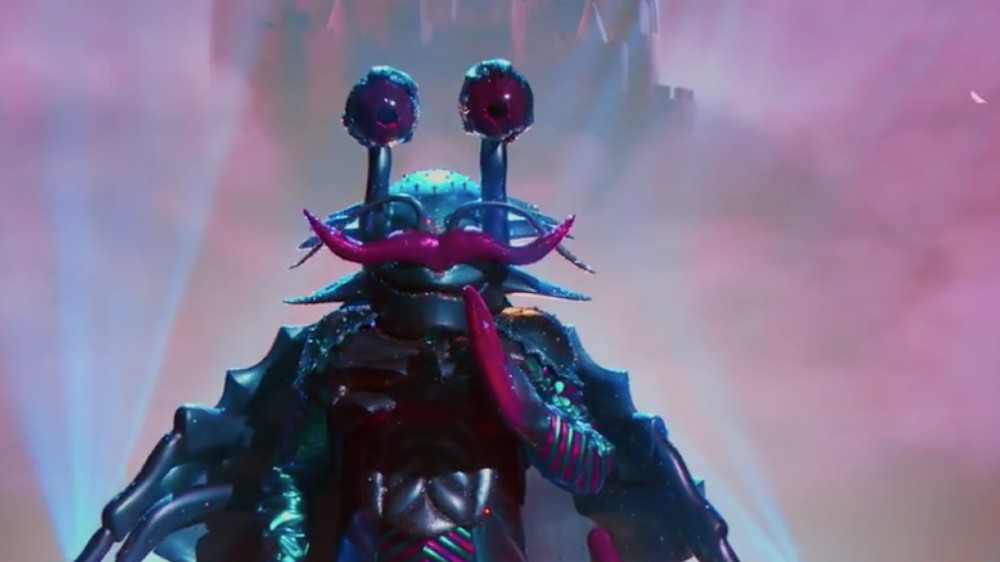
BTL: I was just so excited seeing it onscreen. I remember seeing it for the first time with friends, and freaking out. They were like, “Are you okay?” And I’m like, this is nostalgia right here!
Toybina: That was always so important to me too, because I know that it’s a collector’s item as well. Although I grew up around these dolls being a normal thing in our house, I’ve also known so many people that never visited Russia, never been there, but also have these dogs, and I just thought it was such a significant thing that me, being Russian, and it just made sense. At the same time, it’s something so cool and artistically driven, that the moment and the opportunity presented itself that we just went all for it. So I’m really excited we had a positive response, because it was probably one of the most meaningful questions I built on the show.
BTL: I’m super glad you got to make it. I know for me, I can think of where exactly in my parents’ house the nesting doll is. It hit all the nostalgic emotions, so seriously, I’m so glad you guys got to make that happen this season.
Toybina: It was a dream come true for me. It meant a lot to my family, meant a lot to my friends. meant a lot to me. And like I said, the boys did an outstanding job with all of their performances, of bringing these dolls to life, and I do think it was a well-deserved viral cultural phenomenon. Now the rest of Masked Singer needs to step up and do the dolls as well.
BTL: Let’s cross our fingers. So, going back to build, when you build the mask, what tests do you guys do to ensure vocal quality and movement? Because, with this season, we had a skating Yeti on stage, which was a real test of the costume’s movement.
Toybina: By now, I think we’ve been so fortunate to have this build up of many seasons, having our own trials and errors, and really being so strategic about how we build at this point. We understand where the vocals are. We understand where the vision is. Before we even start building, we’ve really scaled down these costumes. We project them on the wall, see where the human shape is. What dimensions are we working with? Where is their natural eyesight? Where is their mouth? And then, from there, when we start building from the ground up, we understand where the screens have to go. How can we camouflage them into the costume, which Yeti was a perfect example, whose entire jaw was restrained, but nobody could tell because we used a really beautiful hand painting technique to use in all those elements for the fur to really hide that it wasn’t even a foam build, but it was the full vacuum formed screen that went into the costume.
So, we’ve been experimenting a lot now with how can we really manipulate all of our visuals and all of our vocal screens to push into each map for each costume. And then, when it comes down to our own test, when we seal the shell of the mask, we try it out. The fabricators try it out. I always try every single mask on just to see where my proportions are, where’s our vision, and we tweak things as we’re going so, by the time we get into the first fitting with talent, we’re already prepared. What our feedback might be, or this is now getting just the last few notes from them on how can we make this better. So, we just take some time to figure it out, but the majority of it, we have now trained ourselves to really figure it out before we even get it on the celebrity.

BTL: That also brings me to Kermit the Frog. Was there a puppeteer in that snail? I know it’s Jim Henson Company and they are very particular about not showing the puppeteers.
Toybina: Right. Let’s just say that we got very clever. The costume originally, when we were building the snail, we weren’t sure who was going to go into that costume. So, right away, we did kind of compensate for the idea that there could be a person in there, there might not be a person in it. So, we did fabricate a few details inside the costume that allowed us room to make that casting happen. I don’t know how much I can really release there, but it was pretty good to then compensate for the fact that we had Kermit in there.
BTL: To wrap things up, what advice would you give to anyone who wanted to get into this field? I noticed that you attended FIDM, which is an expensive school, so I was curious what advice would you give to anyone who either couldn’t go to school or just wanted to pursue this as a career?
Toybina: I think being an artist, in general, it’s always going to be frustrating because you’re always thinking out of the box, and many times that I’ve mentored students, my biggest advice has been to stay authentic, to stay passionate. I do think education is very important, but I also understand that so many creatives are just by nature beyond brilliant. Sometimes being persistent and also very careful about choices, being able to like research to see who your mentors might be, being able to understand who you are, as an artist. Are you more of an entrepreneur or somebody that wants to sit in and work with studios? I think first figuring out who you are, where your art lies, and either getting a support system around you, or being able to work in an environment that you are an asset. And a lot of networking. I do think you have to push your own boundaries, and you have to work extremely hard to get to the place that you can then understand your value and your worth, and what you’re capable of doing. I do think at some point, people will gravitate toward that.
It is a very difficult journey, but I believe there’s room for so much artistry in the world, and I’ve seen so many incredible people that are coming out of school, even right now that I hope are going to have the brightest future, just because of the creativity is endless. I think it’s just being able to really understand who you are. That kind of self-motivation will push you to be able to find the right people to be involved with. And patience! I think that’s a big one. Being able to be patient with yourself and give yourself room to grow.
BTL: I 110% agree, especially since nothing’s really linear anymore.
Toybina: That’s what I had the pleasure of speaking to a lot of FIDM students lately. I see their fears. I see that it’s almost embedded into their minds that it’s such a complex, competitive world. There’s no room. It’s going to take years to get there. And it’s true. It will take you years to understand who you are. It will take you years to develop your craft, and your techniques, and your value. But, when it comes to competition, I always try to encourage them that nobody else is like you. Nobody else will think like you. What you bring to the table is 100% your authenticity, your take on it. So, I think as long as a lot of artists stick to their guns, and truly master who they are as people and as artists, there’s room for everybody.
The fifth season of The Masked Singer can be watched on Hulu.
All photos are courtesy of Fox, except for the sketches which are also courtesy Ms. Toybina.

